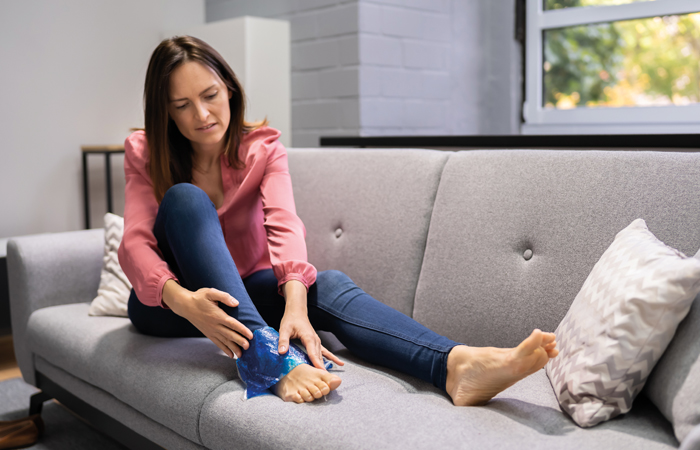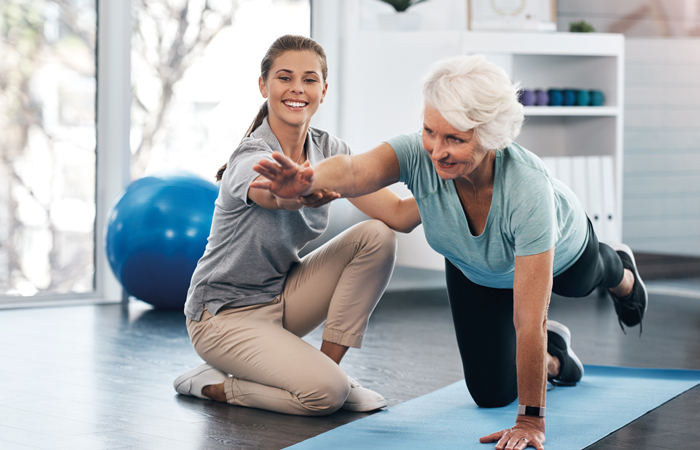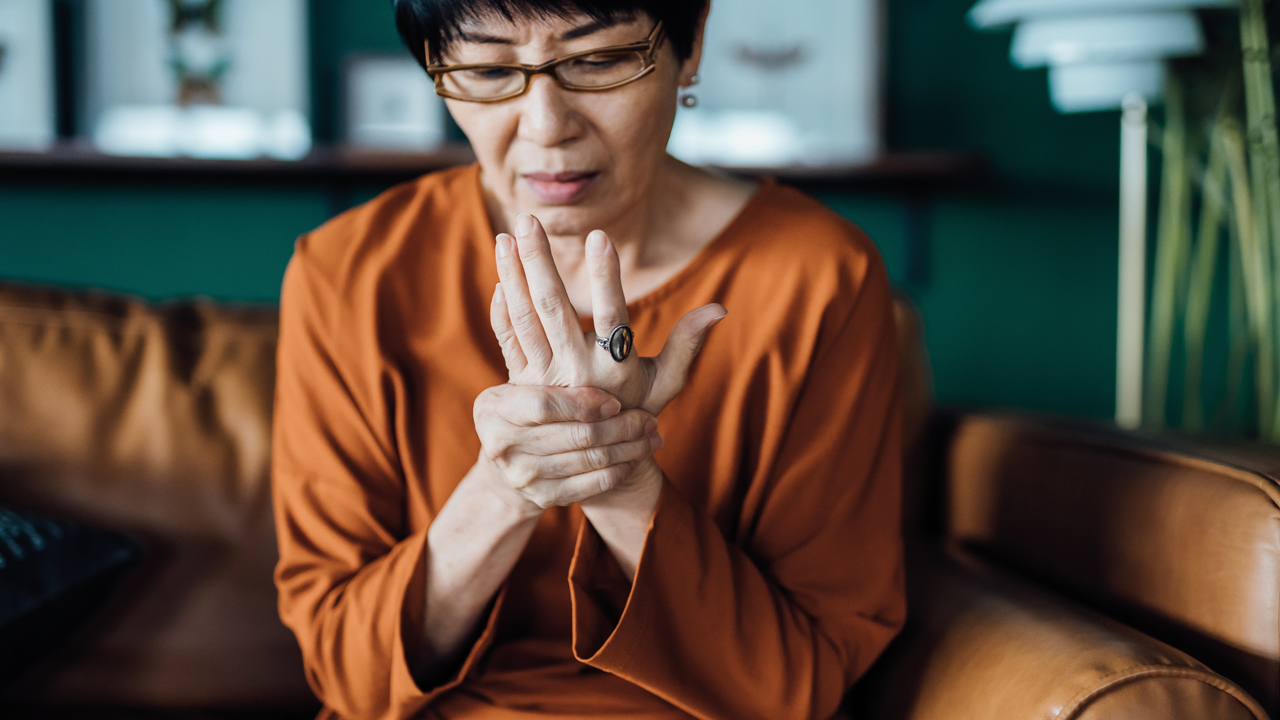In Conditions
Follow this topic
Bookmark
Record learning outcomes
Joints are a little like boilers: people don’t tend to give them a great deal of thought – until something goes wrong. Yet more than 20 million people in the UK – nearly a third of the population – have a musculoskeletal condition (which can affect joints, bones and muscles).
A joint is a place where two bones meet (interestingly, the only bone not directly connected to another is the hyoid in the throat). Ligaments are bands of tissue that connect bones and support joints, while tendons attach muscle to bone. There are several types of joints, including ‘ball and socket’ joints (such as the shoulder and hip), which enable rotating movement, and hinge joints (such as the elbow and knee), which allow a bending and straightening motion. Some joints – for example, in the skull – don’t move at all.
When joint pain occurs, it can be exhausting and frustrating – making everyday tasks such as using stairs or simply getting up in the morning difficult. The NHS advises that people should not attempt to self-diagnose but see their GP if worried. However, once a patient has sought medical advice to establish the cause of the problem, pharmacy staff can also help by providing support and discussing suitable OTC options. As with all medicines, consider the patient’s age and any contraindications, and remind the customer to read the patient information leaflet carefully. Here are some common joint complaints you may encounter:
Arthritis
“Arthritis refers to painful, stiff, or restricted joints,” explains Dr Benjamin Ellis, consultant rheumatologist and senior clinical policy advisor at Versus Arthritis. “It is not a single condition and there are many different types, including osteoarthritis, autoimmune inflammatory arthritis such as rheumatoid or psoriatic arthritis, and crystal arthritis such as gout.”
In the UK, 1,000 people are diagnosed with osteoarthritis every day, says Dr Ellis. “It is commonly mistaken to be simple ‘wear and tear’ that occurs in our joints as we get older, but this is not true. Joints are not like car tyres destined to wear down and be replaced; they are made of complex living tissue that our bodies constantly repair and maintain. Osteoarthritis occurs when the body can no longer properly maintain and repair one or more joints, which causes the cartilage to become thin and uneven, leading to pain, stiffness, swelling and deformity in the joint.”
Meanwhile, more than 2,000 people are diagnosed with rheumatoid arthritis every month, he continues, and around 12,000 children live with juvenile idiopathic arthritis (JIA), another type of autoimmune inflammatory arthritis. “The immune system becomes unbalanced and mistakenly attacks the joints, causing pain, swelling, stiffness and damage to the joints. People with autoimmune inflammatory arthritis require intensive specialist treatment with medicines that control and rebalance the immune system. These medicines can reduce or even stop disabling pain and stiffness, and help prevent permanent joint or spine damage and disability, so it’s crucial that people urgently get the treatment they need.
“Gout is a fairly common form of inflammatory arthritis where urate crystals form in and around the joints. The immune system then attacks the joints where these crystals have formed, causing episodes of severe inflammation, stiffness, pain and damage. Gout occurs when the body’s urate (uric acid) level is persistently too high. Attacks are completely preventable with medicines that lower urate levels in the body – known as urate lowering therapy.”
If someone has gout, Dr Ellis adds, they should see their GP who can prescribe medication to lower their urate level (e.g. allopurinol).
While arthritis can affect anyone, there are some known factors that can increase the risk of developing it. These include:
- Age “Most people with arthritis start to develop their symptoms after their mid- to late-50s,” says Dr Ellis. “By the age of 75, almost one in two of us will have osteoarthritis”
- Sex “About two-thirds of those living with osteo and rheumatoid arthritis are women,” says Dr Wendy Holden, consultant rheumatologist and medical advisor to Arthritis Action. Gout, on the other hand, “is much more common in men”, as well as being “strongly associated with alcohol intake in some people”
- Injury “Injuring a joint earlier in life increases the risk of osteoarthritis in that joint later in life,” says Dr Ellis
- Genes can also play a part, as can factors such as obesity and smoking (more on that below).
The effect that arthritis can have on a patient’s daily life should not be underestimated. It causes “pain, stiffness and swelling in the joints, which can impact people’s ability to perform normal activities such as walking and, if severe, difficulties with self care,” explains Dr Holden. “Fatigue can often be an issue, and dealing with medication and adverse effects can also be challenging. Pain and disability are strongly associated with low mood and anxiety as well as sleep disturbance, and people with arthritis often change their social routine and lifestyle to be able to cope with their condition. For young people with arthritis, work can be impacted, and employers are encouraged to make reasonable adjustments to help people living with arthritis.”
So what can pharmacy teams do to help? “Obviously over-the-counter analgesics such as paracetamol and ibuprofen can be useful for pain, but guidelines advise keeping these to a minimum dose for the shortest possible time to avoid side-effects such as stomach irritation,” says Dr Holden. “Rub-on anti-inflammatory medicines can be useful for single painful joints. Joint supports such as wrist splints can be useful to ease swollen joints, and gel insoles can help reduce pressure on painful feet, but need to be used with shoes that have enough space to accommodate the insole.”
There are plenty of helpful lifestyle tips that you can also dispense to patients. “Healthy eating advice – so that weight is lost slowly but steadily – is probably the most useful advice for anyone with arthritis, as reducing five to 10 per cent in body weight can help reduce pain by as much as a third,” says Dr Holden.
“Stopping smoking is important as this can increase the effectiveness of medicines used for arthritis.” She also suggests staying active and wearing suitable shoes “which should give lots of support and have a thick sole”.
Finally, arthritis can affect every aspect of a person’s life, so don’t assume your only job is to help people with the pain itself, points out Dr Ellis: “They may need advice with mental health and sleep; mobility and home aids and adaptations; employment rights and benefit payments.” Dr Holden says that “signposting to local support groups, exercise classes and mental health services is very important”.
With the right support, patients should hopefully find that their arthritis becomes more manageable. However, anyone who presents with ‘red flag’ symptoms should be advised to seek urgent medical attention, says Dr Holden. These include: “unexplained swelling in a single joint associated with heat or redness or fever (which could indicate a joint infection), weight loss, back or neck pain which is getting worse and causes waking from sleep, neurological symptoms like shooting pains, tingling in the arms or legs, loss of balance, or loss of bowel/bladder control.”
“The effect that arthritis can have on a patient’s daily life should not be underestimated”
Joint supplements
In addition to pain relief and lifestyle changes, patients may be wondering if there are other ways to help their arthritis. “Many nutritional supplements and complementary therapies – while probably harmless – can be pricey and lack good evidence of benefit,” says Dr Benjamin Ellis, consultant rheumatologist and senior clinical policy advisor at Versus Arthritis.
However, Alex Fraysse – a naturopath, herbalist and nutritional therapist, as well as the founder of Spellbound (wearespellbound.com) – says “there are definitely lots of supplements available” for people looking to support their joint health, and that “doing your research ahead of buying is recommended”. He adds that “important ones to look into” include glucosamine, chondroitin, vitamin D3 with K2, collagen and Omega 3.
However, patients shouldn’t start scoffing every supplement they can get their hands on. “There is always a limit”, he warns, adding that people should refer to their healthcare provider for more information, as “this may vary depending on whether you are on medication that needs to be checked against the supplements recommended”.
Sprains and strains
Although people often use the terms sprains and strains interchangeably, they’re not exactly the same. A sprain means a ligament is stretched, twisted or torn, while a strain involves the muscle fibres and/or tendon (often called a “pulled muscle”). According to the National Institute for Health and Care Excellence (NICE), sprains typically affect the ankles, knees, wrists and thumbs, while a strain typically affects the foot, hamstring and back.
Sprains and strains are more common in people who regularly take part in sport but they can also be caused by an accident, or even simply lifting a heavy object. Signs can include tenderness, inflammation, bruising and muscle cramps/spasms. Patients may also find it difficult to use that part of the body normally or put weight on it.
Most minor strains and sprains can be dealt with at home and will usually improve within a fortnight, although it is advised that people should avoid strenuous exercise such as running for up to eight weeks. Self care is important, with the RICE method traditionally being recommended for the first couple of days:
- Rest: Stop activity and protect the part
- Ice: Regularly apply an ice pack (or bag of frozen veg) wrapped in a tea towel to the injury to help reduce swelling (NICE advises for 15-20 minutes every two to three hours during the day)
- Compression: Wrap a bandage securely – but not too tightly – around the injury (if it’s too tight, the patient may experience tingling, numbness, pain, or swelling in the surrounding area). Remove it before sleeping
- Elevation: Raise the injured area above heart level, using a pillow for support.
Suitable pain relief such as ibuprofen (which reduces inflammation, and comes in various forms such as tablet, liquid, gel or spray options) or paracetamol can help to ease discomfort. Aspirin should not be given to children under 16 (unless specifically indicated by a specialist), according to NICE, due to the risk of Reye’s syndrome.
In many cases, patients can treat a strain or sprain themselves, but if they heard a crack or think they may have broken a bone, they should go to A&E.

An icepack can help reduce swelling after a strain or sprain.
Joint infection
An infection, such as septic arthritis, can arise when germs get into the joint. For example, after an injury or surgery, or via the bloodstream. Symptoms can include severe pain, swelling, redness, limited mobility and a fever. It typically – but not always – affects one joint and can often develop suddenly. If a joint infection is suspected, the patient should be advised to seek immediate medical attention.
How exercise can help
“There is overwhelming evidence that physical activity not only improves joint function, reduces disease activity and improves cardiovascular health, but that it can also help with pain management and mental wellbeing,” explains Dr Benjamin Ellis, consultant rheumatologist and senior clinical policy advisor at Versus Arthritis. “It can be hard to keep moving when you have arthritis, especially when in pain... [however], staying active is one of the best ways to reduce the impact of arthritis, because too much rest can weaken joints, making pain worse in the long run.”
Dr Ellis says a mixture of exercises can be recommended, with the main types as follows:
- Stretching: “These involve bending and straightening your joints as much as is comfortable to keep them flexible and reduce the risk of any loss of mobility”
- Strengthening: “Having strong muscles helps keep joints stable and can reduce pain in the joints and the tissues around them”
- Fitness: “Fitness exercises are important for everyone to stay healthy. They include things such as cycling, swimming and exercise classes”
- Balance: “It’s important to do exercises to improve balance on two days a week, particularly as people get older. This will help reduce the risk of falls, which can have more complications as we age. There are specific balance exercises that can help, but things like playing bowls, doing tai chi or dancing – either at classes or around the home – improve balance too. If practising balance at home, people should make sure the area around them is clear of anything that could trip them up.”
Versus Arthritis runs the Let’s Move with Leon programme, a free online series of exercise videos designed to help people with arthritis exercise at home without special equipment. Find out more at: versusarthritis.org.
Let’s Move for Surgery is a specific set of videos to support people in preparing for and recovering from joint replacement surgery.

Keeping up a range of activity improves joint function and helps with pain management.

